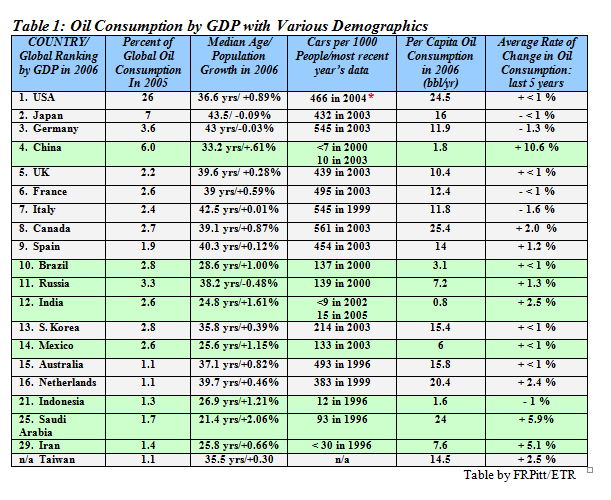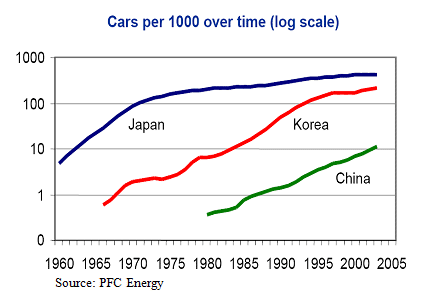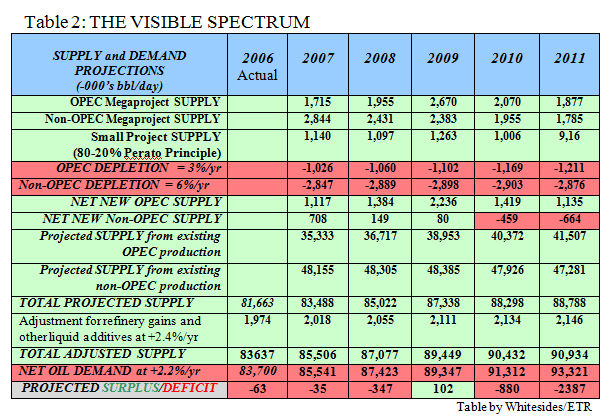|
FRIDAY EDITION December 5th, 2025 |
|
Home :: Archives :: Contact |
 |
FuelhardyRichard Karn Emerging Trends Report August 1, 2007 EXECUTIVE SUMMARY: Fuelhardy Executive Summary Let us for a moment adopt the sunniest of outlooks for the transportation fuel sector in the United States and assume all of the programs either underway, under development or proposed are successfully implemented. Let us for a moment accept:
But the reality is America’s transportation fuel supply is anything but secure, for we are just starting to undertake these projects now and the viability of at least half of the list above is by no means assured. More disturbing, even if all of these projects are successfully implemented, it will require at least a decade, and more probably two, to “make a sharp reduction in (US) dependence on imports”; and in the meantime we are but one country of many competing for a disproportionate share of a shrinking global pool of oil. We have placed ourselves in a position where we are relying on sources of oil the Emerging Trends Report (ETR) simply does not believe will be available in the quantities we will require in but a few years’ time. Increased global consumption and competition for available supply is running headlong into barriers erected by production constrictions and reinforced by resource nationalization and resource mercantilism. If the American public wishes to avoid being blind-sided by a ‘crisis’ 35 years in the making, two smug misconceptions simply must be dispelled:
Unfortunately, while we have been captivated by Intelligent Design and Paris Hilton in stripes, OPEC and the BRIC (Brazil, Russia, India and China) economies have been busy rewriting the rules of the Great Game, most notably designating oil and natural gas as strategic assets rather than the mere commodities we take for granted. There is now and will continue to be a market for oil we imperiously presume is earmarked for the USA. Sophisticated oil field technology can be purchased on the open market, often from American companies that are more than willing to pick up where the increasingly impotent IOCs left off. And a coordinated effort to politicize energy, keeping oil prices high by restricting supply and doling it out on a most-favored nation basis, is increasingly undermining free market operations, OECD countries’ primary defense against targeted embargoes. That is the new reality Americans have been studiously ignoring, and though it will add urgency to the projects mentioned above, there is little that can realistically be accomplished in the intermediate term to offset coming increases in both oil prices and volatility as Americans are neither prepared nor disposed to conserve oil. And with all due respect to the US Congress, comedy aside, the ETR does not think sound-bite solutions such as threatening to sue OPEC on anti-trust grounds really carry much weight these days. Since the release of our first report on Halloween of 2005, the ETR has endeavored to identify avenues of long term investment, position clients early, and aside from three specific recommendations, to eschew sovereign risk by only investing in the US, Canada, Mexico and Australia. Globally, emerging markets have been on fire and our annualized 40% return seems paltry by comparison. But we have steadfastly adhered to this conservative, low stress approach because we place a large premium on sleeping well at night. This notion of sleeping peacefully will become increasingly important as governments seize all manner of producing assets without recourse or recompense. And nowhere will the ETR approach manifest itself with more impact or greater long term profitability than in the realm of transportation fuels. In preparation for this eventuality, we have compiled a 45-page comprehensive report, which concludes with a portfolio of 29 stocks completely devoid of sovereign risk balancing best-of-breed companies with those offering innovative technologies, solutions and services that will prosper in the years ahead.
Detail 1: On the Shoulders of Giants Once oil dethroned coal as the planet’s primary form of transportation fuel in the 1920’s, global economic output began doubling every decade. Harnessing the energy contained in oil is directly correlated with the Gross National Product (GDP) of every country on earth, and though it may be simplistic it is not an exaggeration to say the more oil a country uses, the larger that country’s economy and the more amenities it can offer its citizens. The United States has always epitomized this concept, though the formula clearly has not been lost on the rest of the world:
Demographic trends in these top oil consuming countries provide a glimpse of what we can expect in terms of global oil demand in the years ahead as developing economies industrialize and their oil needs increase (please refer to the table on next page).  *NOTE: In an effort to maintain consistency in the comparison with other countries, this figure only includes registered passenger cars. The same loophole which allows SUVs and light trucks to escape the penalties which should be imposed for violating US passenger car mileage standards disallows their being counted as such; if SUVs and light trucks were included in this figure, such are their popularity that this figure would exceed 800 cars per 1000 people. It is not a coincidence that the countries shaded in gray represent the most developed economies on the planet while those in green represent arguably the most vibrant. Note that with the world per capita consumption of oil being 4.68 barrels of oil per person per year, developed countries universally consume multiples of the average while of the emerging economies, with the exception of the oil-producers Saudi Arabia, Mexico, Iran and Russia, none exceed the average. Certainly this will change. The largest economies, characterized by high but stable oil consumption, have mature populations and the most saturated automobile markets in the world. Demographic trends suggest their very level of development precludes dramatic growth in any category in the future beyond that reflective of population growth. Led by China, the nations shaded green have spurred global economic growth in excess of 5% annually for the last five years. The combination of strong growth in manufacturing and petrochemical industries, infrastructure build out, expanded automobile production and ownership, and an increasing number of low-cost regional airlines has pushed global oil demand up by about 1.8 million barrels per day (mb/d) during this same period to an average 83.7 mb/d in 2006, a new record. By and large these vibrant economies have young populations, expanding middle classes, and low automobile saturation rates: the perfect formula for explosive growth in future oil demand—just as it was for the gray countries in decades past when they were in an earlier stage of their economic development. Using automobiles as an accessible, if generalized, proxy to put this growth in perspective, consider that the BRIC countries alone are expected to account for 47% of all passenger car sales during this decade. This growth is typified by China, which brings new dimensions to the Asian Tiger model of exporting its way to riches and raises the question of what will happen if China also approximates Japanese and South Korean growth in terms of automobile ownership. Last year China’s car sales were up about 40% to 4.1 million units, which was well in excess of the 3.4 million sold in Germany. During their formative stages, once Japan and South Korea crossed the 10-car per 1000 person threshold, car ownership made an exponential leap to 100 cars per 1000 people within less than a decade and a half. As illustrated on the following chart, China surpassed this threshold in 2003: 
Should China’s growth model follow a similar trajectory, the sheer numbers involved are staggering. Given their more humble economic base and using the more conservative timeframe, if it takes fifteen years for China to reach the 100 cars per 1000 people level, the current rate of population growth indicates they will have more than 144 million cars by 2018—more than the 136 million registered passenger cars in the US in 2004 (excluding SUVs and light trucks). Meanwhile in India, the other country with a population in excess of 1.1 billion people, less than one percent now own cars but sales are growing at a rate of 20% per year. Further, though figures are inconsistent, the widespread evolution from bicycle to motor scooter is well underway and contributing significant demand for oil. The International Energy Agency (IEA) has estimated that the 3 to 4% annual growth in oil consumption from China and India alone will require an additional 30 mb/d by 2030--in other words, three more Saudi Arabias will have to be found and brought on stream just to meet their needs. And as we go to press, the IEA has just revised its February 2007 estimate for growth in global oil consumption from 2% to 2.2% per year through 2011. With demand destruction not materializing as predicted and supply effectively being set early into the next decade, the ETR expects there to be further demand revisions forthcoming. In the case of developed nations, if oil consumption remains static as the demographic trends suggest, declines in domestic production will have to be replaced by a commensurate increase in imports. Non-OPEC decline estimates, which have been widely viewed to run in the range of 4-5% per year, may in fact be too optimistic: Schlumberger and Baker Hughes executives have suggested that advanced extraction technologies place decline rates closer to the 8-12% per year range, and large fields may decline by as much as 20-25% per year. The faster these countries’ domestic oil production declines, the more pressure it will exert on global production, so with non-OPEC countries’ decline rates running at 3 mb/d, or more than 6% per year in 2006, more new supply will need to be used to offset declines than is currently estimated. OPEC does not release decline figures, and though it is widely reported that many of the older oil fields in Kuwait, Iran, Iraq and Indonesia are in decline, the extent is unknown. This means generating a reasonably accurate overview of the supply and demand picture of the global oil markets is problematic. What we have chosen to do in the following table is to assign OPEC production a decline rate half that of non-OPEC production, which we believe is a very conservative, exceedingly optimistic approach. Even so, as the following table shows, the picture is grim: 
In the very least what emerges is a picture of a very finely balanced market in which any minor exogenous shock could have an unusually disruptive effect on supply and demand dynamics. Barring a recession, the ETR expects this will continue to manifest itself in intensified competition for supply as well as significantly more volatile but generally higher prices in the near and intermediate terms. Apparently, the governments of China and India have come to a similar conclusion and view securing oil supply as too important to be left to free market operations, as is witnessed by the recent spate of deals they have brokered with oil-producing nations in Africa and elsewhere for ‘off-market’ supply (please refer Detail 3). Many analysts, however, insist the planet is not in imminent danger of running out of oil, for reserves have long had a habit of being revised upward to reflect new finds, technological advancements that have increased recovery efficiency, extensions of existing fields and the like. What the planet is evidently running out of is cheap, easily accessible, abundantly productive oil fields—and of that there is little debate. There are roughly 47,500 producing oil fields in the world today. Of these, 507 are giant fields, each with recoverable reserves in excess of 500 million barrels of oil: the so-called elephants. The largest of these by far, for example, is Ghawar in Saudi Arabia, which has been producing more than 5 mb/d for longer than most of us have been alive. Distribution of these giant fields is very uneven: the largest concentrations are in the Persian Gulf, which is home to roughly 28% of the world’s giant oil fields, followed by Russia, North America and Africa. However, OPEC controls roughly 46% of the known giant fields, which goes a long way in solidifying their power over the oil markets. The significance of giant oil fields cannot be overestimated. Giant oil fields not only account for roughly 65% of global oil reserves but also produce more than 60% of the world’s oil. Critically, a giant produces very large volumes of oil for an extended period of time, which means not only a lower production cost per barrel but also that it is not feasible to match its production and longevity simply by substituting production from a large number of smaller fields regularly brought on stream—except at substantially higher costs. And ever more remote oil is becoming ever more expensive to discover, extract, transport and refine. Supply issues are understandably foremost on oil executives’ minds. The majority (60%) of a recent KMPG poll see declining reserves as irreversible and worsening, which means any giant field going into decline has serious implications for the global production picture—and plenty are in decline. Notable giants in decline today include Prudhoe Bay in Alaska, Cantarell in Mexico, Daqing in China, Burgan in Kuwait, Samotlar in Russia, and the North Sea fields operated by the United Kingdom. But despite record oil prices and a near doubling of Capital Expenditures (CAPEX) to $44 billion per year between 2000 and 2005, the four largest international oil companies (IOC’s) in the world have not been able to increase either their production or their reserves. With roughly 80% of the oil we are consuming today having been discovered before 1973, we are finding less than one barrel of oil for every five we consume, which is patently unsustainable:
Combined, the 14 giant oil field discoveries between 2000 to 2006 amounted to just over 20 billion barrels of oil reserves, with just one field, Kashagan in Kazakhstan, accounting for nearly half of that figure. Importantly however, Kashagan was not a new discovery: it was originally found by Soviet geologists during the Cold War and not developed. Of the 14 giant fields found, 11 were found offshore, and 8 of those were found in deep water; clearly such fields are becoming more difficult to find and more expensive to bring into production. Much of the investing community cavalierly assumes that should oil prices go high enough, demand will slacken and sufficient oil will be found from either conventional primarily Persian Gulf sources or unconventional offshore, tar sand or heavy oil sources to slake the planet’s thirst. The Emerging Trends Report weighs the rapid growth in oil demand, the shift toward unorthodox political methods of securing future supply, and the time and technical difficulty involved with most of these new projects and can but conclude that someone’s share of the global oil supply will be reduced, perhaps sharply—and the US is far more vulnerable in this regard than it imagines. “Fuelhardy” constitutes the most comprehensive work produced by the Emerging Trends Report to date and is intended to present an enduring evaluation of the transportation fuels sector in the US. 45 pages of documented research are supported by 9 charts and 3 original tables covering:
To purchase “Fuelhardy” as an individual report, or on an annual subscription basis, we invite you to visit our website: http://www.emergingtrendsreport.com Richard Karn/Emerging Trends Report August 1, 2007 (510)962-5021 |
| Home :: Archives :: Contact |
FRIDAY EDITION December 5th, 2025 © 2025 321energy.com |
|